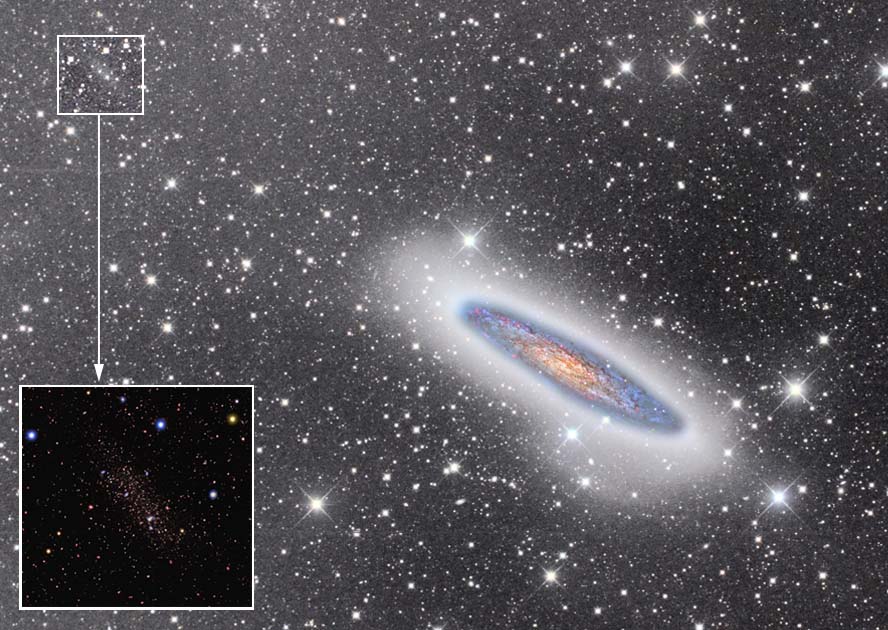All amateur Michael Sidonio wanted was a pretty astro-image of the spiral NGC 253. What he got instead was credit for discovering a rare dwarf galaxy.

Michael Sidonio
By day, Australian amateur Michael Sidonio is an imposing physical presence. The picture at right tells you everything you need to know. He's a big guy who works as a security manager for the legislative assembly in Canberra, Australia's capital. But some years ago he was an accomplished regular on the Australian "strongman" circuit. He was twice captain of the country's strongman team, and his picture even graced some cereal boxes.
But he gave up competing in 2002 and returned to his childhood passion: astronomy. Now, by night, he prowls the southern sky with the telescopes and CCD camera at his Terroux Observatory, about a half hour's drive from the center of Canberra.
It was there, back in October 2012, that he recorded some snaps of the Sculptor Galaxy, NGC 253. It's an intermediate spiral about 11½ million light-years away, and it's adorned with lots of crimson-hued star-forming regions that make it a favorite with astrophotographers.
Sidonio was just trying for a pretty picture, but later he noticed a small, elongated smudge off to one side. He didn't see it plotted on any of his reference charts, but he figured professional astronomers must know about it. Well, they didn't, and that triggered a succession of observations with ever-larger professional telescopes — culminating with the powerful Suprime-Cam on Japan's 8-m Subaru Telescope.
That little smudge, now designated NGC 253-dw2, turns out to be a dwarf galaxy that the much bigger spiral galaxy is in the process of gobbling up via tidal disruption (as implied by its elongated shape). The galactic straggler lies about 160,000 light-years from NGC 253; that's about as far as the Large Magellanic Cloud is from us, easily close enough to be held within NGC 253's gravitational death grip.

M. Sidonio / A. Romanowsky & others
It's an important find, as Aaron Romanowsky (San Jose State University) and nine coauthors — including Sidonio — detail in a forthcoming issue of Monthly Notices of the Royal Astronomical Society. It seems that a well-accepted assumption that spiral galaxies grow and evolve by consuming lots of galactic small fry in their vicinity is in some distress. For one thing, dwarf galaxies are scarce in the Milky Way's immediate neighborhood, though by some counts the total might be 30 (out to 1.4 million light-years).
This big-fish-eat-small-fish hierarchy is a key prediction of the modern cosmological paradigm of cold dark matter with a cosmological constant (ΛCDM). However, as Romanowsky's team notes, "These tensions between observation and theory have led to doubts about the standard model" — so finding that NGC 253 is about to chow down provides a crucial observational test for the distribution of dark matter around it.
Meanwhile, Sidonio, the self-proclaimed World's Strongest Astronomer, is relishing the chance to contribute at such a significant level. It turns out that amateurs equipped with fast f/ratio optics and sensitive electronic cameras can sweep up faint low-contrast objects better than large-scale professional surveys have. When I emailed Sidonio this morning, a reply popped back right away despite the extreme time-zone difference. "Actually, it is 1:30 a.m. here, and I've just been out celebrating with a few friends and a few cold beers," he quipped.
Click here to read more about Sidonio and his astronomical pursuits, and click here for a nice write-up and video by the Canberra Times.
It's worth noting that, while taking nothing away from Sidonio's serendipitous discovery, another team has independently reported finding the dwarf galaxy in question. Elisa Toloba (Texas Tech University) and other observers spotted it on images taken in November 2011 and October 2014 with the Magellan Clay 6.5-m telescope in Chile. It's not known whether Elisa and her colleagues went out to drink beers after news of the discovery was announced.
 3
3
Comments
Anthony Barreiro
January 8, 2016 at 8:46 pm
What an inspiring story! Keep looking up, you might see something new.
You must be logged in to post a comment.
Aqua4U
January 9, 2016 at 2:22 pm
It is so very cool for amateurs to see a fellow amateur astronomer make a unique discovery like this! In deed, it is WAY double extra groovy cool! Consider me inspired!
You must be logged in to post a comment.
January 16, 2016 at 4:27 pm
"that he recorded some snaps of the Sculptor Galaxy"
Selfies and candid photos of your dog are "snaps"...
You must be logged in to post a comment.
You must be logged in to post a comment.